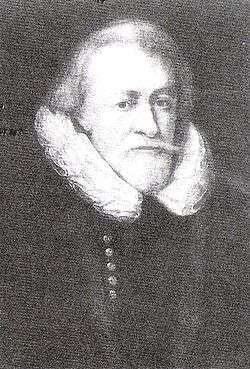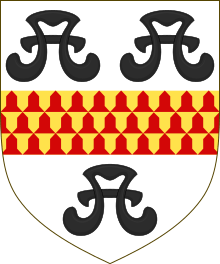William Dethick
Sir William Dethick (c. 1542–1612) was a long-serving officer of arms at the College of Arms in London. He was the son of Sir Gilbert Dethick and followed his father as Garter Principal King of Arms. Though he was adjudged a qualified armorist and antiquarian, Dethick's biography is notable for numerous instances of conflict with his colleagues and others.

Heraldic career
William Dethick was educated at St John's College, Cambridge.[1] He was appointed Rouge Croix Pursuivant of Arms in 1567 and York Herald of Arms in 1570. His father and predecessor as Garter, Sir Gilbert Dethick died in March, 1584. The office of Garter was held vacant for two years, during which time Clarenceux King of Arms Robert Cook served as interim Garter. On 21 April 1586, William Dethick was appointed Garter.
In May 1604 William Dethick was sent by King James to Frederick I, Duke of Württemberg with Sir Robert Spencer.[2] They presented jewels including two garters with diamonds and rubies, and two St Georges with diamonds and rubies, and a gold chain or collar, made by the London goldsmiths, John Spilman and William Herrick.[3]
Personal character
Biographers note that Dethick was embroiled in strife throughout his career to a degree notable even for his time period, including numerous accusations of physical assault.[4] In 1573 Mary White, the wife of Chester Herald reported that Dethick assaulted her with a coal basket and rubbed hot ashes into her hair.[5] He was also reported to have attacked his father with his fists, stabbed his elder brother, and stabbed another man while at a funeral in Westminster Abbey.
In his professional capacity his qualifications were high and he was judged by his peers a skillful herald, but he was a constant transgressor. As York Herald, he confirmed arms under his own seal, thus usurping the prerogative of the Kings of Arms. He was also able to secure extra powers in his patent of appointment as Garter King of Arms by bribing the Clerk of the Signet. When a royal commission was established to examine the irregularities, Dethick surrendered his patent though he continued in the office. In January 1604, the authorities appointed William Segar as Garter. Dethick resisted his deposition until 1606 when he was given a pension of £200 per year.[6]
Dethick was knighted by King James I of England and VI of Scotland on 13 May 1603. He died in 1612 and was buried in St Paul's Cathedral. The grave and monument were destroyed in the Great Fire of London in 1666. His name appears on a modern monument in the crypt, listing important graves lost in the fire.
Arms
 |
|
Notes
- "Dethick, William (DTK559W)". A Cambridge Alumni Database. University of Cambridge.
- John Nichols, The Progesses, Processions, and Magnificient Festivities, of King James the First, vol. 1 (London, 1828), p. 282-289.
- HMC Laing Manuscripts at the University of Edinburgh, vol. 1 (London, 1914), pp. 93-7: HMC 2nd Report (London, 1874), p. 20.
- ’’Heralds of England’’ Sir Anthony Wagner.
- BL, MS Lansdowne 18, f5.
- ”The Coat of Arms” No. 206, 243.
- Godfrey, Walter H; Wagner, Anthony (1963). "'Garter King of Arms', in Survey of London Monograph 16, College of Arms, Queen Victoria Street (London, 1963), pp. 38-74". british-history.ac.uk. Retrieved 2018-11-01.
External links
| Preceded by Henry Cotgrove |
Rouge Croix Pursuivant 1567–1570 |
Succeeded by Thomas Dawes |
| Preceded by Ralph Langman |
York Herald 1570–1586 |
Succeeded by Humphrey Hales |
| Preceded by vacancy |
Garter King of Arms 1586–1606 |
Succeeded by William Segar |